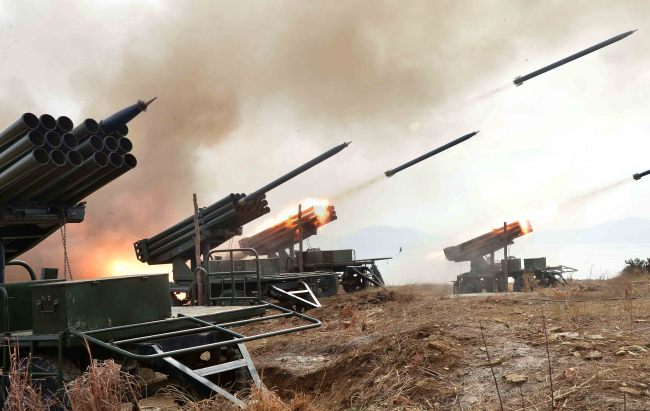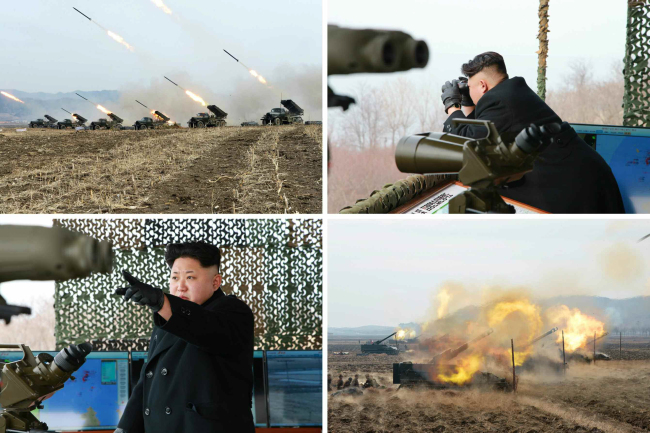N.K. continues saber-rattling over holiday
Seoul denies speculation that Pyongyang tested submarine-based missile
By Korea HeraldPublished : Feb. 22, 2015 - 18:41
North Korea conducted military drills last week to “strike and occupy” South Korea’s northwestern border islands in an apparent show of force ahead of the Seoul-Washington annual defense exercise to begin early next month.
According to the North’s state media, North Korean leader Kim Jong-un and the regime’s top brass including Hwang Pyong-so, director of the general political bureau of the Korean People’s Army, observed the drills.
The media did not specify exactly where and when the drills were conducted. But Seoul officials think the drills were held Friday in Nampo, on the western coast.
According to the North’s state media, North Korean leader Kim Jong-un and the regime’s top brass including Hwang Pyong-so, director of the general political bureau of the Korean People’s Army, observed the drills.
The media did not specify exactly where and when the drills were conducted. But Seoul officials think the drills were held Friday in Nampo, on the western coast.

“Troops under the 4th Corps of the Korean People’s Army carried out the drills to strike and occupy the islands at a time when passionate troops were keen on achieving the goal of national reunification,” the North’s Korean Central News Agency reported on Saturday.
Underscoring the deterioration in relations between Washington and Pyongyang, KCNA pointed out that the drills targeted the U.S.
“Our troops in the units along the southwestern front were full of determination and resolve to retaliate against the U.S. imperialists and their sympathizers,” the KCNA said.
“The drills were aimed at confirming the practicality of our combat plan that was drawn up to devastate and occupy the islands should a fight break out.
The North’s 4th Corps, which participated in the drills, was thought to have masterminded the 2010 artillery attack on South Korea’s border island of Yeonpyeongdo, which killed two marines and two civilians.
A Seoul official said that the North mobilized surface-to-ship Silkworm missiles, ground-to-air SA-2 missiles and 122-mm multiple rocket launchers for the live-fire drills.
The Silkworm missile has a range of up to 95 kilometers and has been used to threaten South Korean patrol ships operating near the Northern Limit Line, a de facto inter-Korean maritime border that the North has long attempted to nullify.
The SA-2 missile has a range of 48 km and has been deployed to shoot down hostile aircraft. The North is thought to have about 180 SA-2 missiles. The 122-mm multiple rocket launchers have a range of about 20 km and have been deployed to target the South’s border islands.

Meanwhile, the U.S. Internet media outlet, the Washington Free Beacon, reported last week, citing Washington officials, that the North had conducted the first flight test of a new submarine-launched ballistic missile last month.
The report said that the flight test of the KN-11 missile took place on Jan. 23 off the coast of North Korea from a sea-based platform. It added the flight test followed a land-based ejection test of the missile last November from a static launcher located at the North’s Sinpo South Shipyard.
Seoul officials, however, said the report was untrue. They said that the launch was just a test of a vertical missile launcher in a coastal area, and did not involve a sea-based platform.
“The reports on a flight test of the SLBM were different from the truth. It was a test of a vertical launcher, not a flight test,” a Seoul official told media.
Seoul and Washington have carefully monitored the North’s development of an SLBM, which could give Pyongyang the ability to launch a retaliatory nuclear attack. Along with the nuclear bomb and intercontinental ballistic missile, the SLBM completes the strategic nuclear arsenal, which experts call the “nuclear triad.”
By Song Sang-ho (sshluck@heraldcorp.com)
-
Articles by Korea Herald




![[Herald Interview] 'Amid aging population, Korea to invite more young professionals from overseas'](http://res.heraldm.com/phpwas/restmb_idxmake.php?idx=644&simg=/content/image/2024/04/24/20240424050844_0.jpg&u=20240424200058)

![[Pressure points] Leggings in public: Fashion statement or social faux pas?](http://res.heraldm.com/phpwas/restmb_idxmake.php?idx=644&simg=/content/image/2024/04/23/20240423050669_0.jpg&u=)













